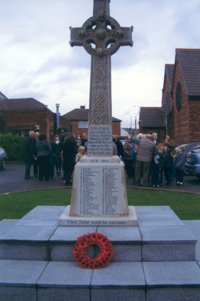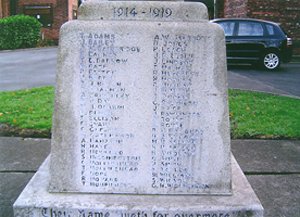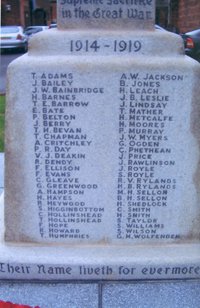Showcase result
Swinton
Town or City: Swinton
County: Greater Manchester
Country: England
WMT Reference Number: WM2158
Value of grant: £2500.00
Type of memorial: Freestanding
Type of work: Conservation and repair
Grant scheme: Small Grants Scheme
Year: 2007
UKNIWM reference number: 45507
 This war memorial is in the grounds of Holy Rood Church, Swinton, Salford. It is a grade II listed granite Celtic cross engraved with Celtic designs and stands on a three stepped plinth, which itself stands on a two stepped base.
This war memorial is in the grounds of Holy Rood Church, Swinton, Salford. It is a grade II listed granite Celtic cross engraved with Celtic designs and stands on a three stepped plinth, which itself stands on a two stepped base.
In 2007 War Memorials Trust gave £2,500 towards work to re-paint the lettering, clean the stone work and repoint the joints. In addition, the existing paving around the memorial was removed and a concrete base onto which paving flags to match the original would be laid.
At the base of the shaft of the cross, on the south west face, is the inscription
This cross
was erected in
loving and grateful
memory of the
men of this parish
who made the
supreme sacrifice
in the Great War.
1914-1919
Below that, on the side of the main step of the plinth, are inscribed the names of the men who died
T. Adams
J. Bailey
J.W. Bainbridge
H. Barnes
T.E. Barrow
E. Bate
P. Belton
J. Berry
T.H. Bevan
T. Chapman
A. Critchley
P.R. Day
V.J. Deakin
R. Dendy
F. Ellison
F. Evans
C. Gleave
G. Greenwood
A. Hampson
H. Hayes
R. Heywood
S. Higginbottom
C. Hollinshead
T. Hollinshead
F. Hope
R. Howard
T. Humphries
A.W. Jackson
B. Jones
H. Leach
J.B. Leslie
J. Lindsay
T. Mather
H. Metcalfe
H. Moores
P. Murray
J.W. Myers
G. Ogden
C. Phethean
J. Price
J. Rawlinson
J. Royle
S. Royle
H.B. Rylands
R.V. Rylands
B.H. Sellon
M.H. Sellon
H. Shedlock
C. Smith
H. Smith
S. Taylor
S. Williams
S. Wilson
G. H. Wolfenden
followed by: Their name liveth for evermore
On the side face are the Second World War dates and names
1939 - 1945
J. Aitken
J. Collier
H. Gilbert
K.R. Hickling
D. Haydock
R.J.H. Hornby
R.W. Laybourne
H. Minton
J. Pace
J. Pendlebury
C. Russell
G.R. Sneyd
I.M. Williams
 On the south east face there is an inscription “1939-1945” on the top narrow step of the plinth, and on the main step of the plinth below this are inscribed the names of those who died in the Second World War.
On the south east face there is an inscription “1939-1945” on the top narrow step of the plinth, and on the main step of the plinth below this are inscribed the names of those who died in the Second World War.
The memorial was funded by public subscription in the parish and was erected in about 1920. It was unveiled by Sgt. Barret Evans one of the first parishioners to join up in 1914. The dedication service, which was held on the night of Ascension Day, was well attended, and included the Holy Rood Scouts and Guides. The memorial was re-dedicated after the work on 19th October 2008 at a ceremony attended by the military and local dignitaries.
The earliest casualties on the Swinton memorial are men who fell during the Gallipoli campaign. Capt. Reginald Ryland’s division arrived to reinforce the garrison at Gallipoli in May 1915, having come from Egypt where they had been sent early in the war to guard the Suez Canal. The Division was involved in three notable attempts to break out of the Helles bridgehead to capture the heights around the village of Krithia from the Ottoman forces. Captain Rylands died on 29th May, three weeks after the first attempted break out. Pte. Ogden served in the same division as Capt. Rylands, and would have been involved in the third attempt to break out of the bridgehead, the Battle of Krithia Vineyard 6-13 August, so as his date of death is recorded as 7th August, it seems likely that this is where he died. By mid August 1915 the East Lancashire Division, through battle casualties and sickness, was reduced in number to less than a third of its normal numbers.
 Capt. Rylands had a younger brother, a Second Lieutenant in the same regiment, the Lancashire Fusiliers. 2nd Lieut. Ryland’s division was present at the battle of Ancre in mid-November 1916, one of the engagements of the battle of the Somme, and as his date of death is recorded as shortly after this, we can perhaps conclude that he died of his injuries. Thus their parents, Richard and Mary Rylands of Ashburn Lodge, Worsley, lost two sons in eighteen months.
Capt. Rylands had a younger brother, a Second Lieutenant in the same regiment, the Lancashire Fusiliers. 2nd Lieut. Ryland’s division was present at the battle of Ancre in mid-November 1916, one of the engagements of the battle of the Somme, and as his date of death is recorded as shortly after this, we can perhaps conclude that he died of his injuries. Thus their parents, Richard and Mary Rylands of Ashburn Lodge, Worsley, lost two sons in eighteen months.
Corp. Deakin, commemorated on the memorial, also died at the Somme; he died at the end of July 1916, during the first phase of the battle. Corp. Shedlock died during the capture of the Munich Trench, one of the engagements on the river Ancre that followed the battle of the Somme. Another notorious battle on the Western Front was Passchendaele, or the Third Battle of Ypres. Ptes. Barrow and Higginbottom died here.
One of the lesser known fronts of the First World War is the Italian front. The Italians were fighting the Austro-Hungarian army, allies of the Germans. In November 1917 six divisions of French and British troops had arrived in Mantua, north-east Italy. Pte. Hollinshead of the Royal Army Medical Corps died on 1st October 1917 and is buried in Ravenna War Cemetery, so it seems likely that he died on his way to the front. The Italians were soundly defeated at the battle of Caporetto and this caused the British and French to send reinforcements. In June 1918 the British fought the Austro-Hungarian Empire troops on the Asiago Plateau, forty miles north of Venice; the objective of the Austro-Hungarians was to capture Vicenza. British positions were at 3, 000 feet elevation, flanked by mountains twice as high and although they were attacked they held their positions. 2nd Lieut. Marmaduke Sellon died on the opening day of this battle. Five months later the Austro-Hungarian army tried to push forward the front line they had established at the battle of Caporetto but were thoroughly defeated by the Italians at the battle of Vittorio Veneto. Following this, the Austro-Hungarian empire fragmented into different ethnic-based states and withdrew from the war.
2nd Lieut. Sellon had a younger brother, also a 2nd Lieut., Bruce Sellon, who had been in the London Regiment. Bruce Sellon died on the Western Front in August 1917. Their parents, Ernest and Annie Sellon, lost two sons in the space of ten months.
Lance Corporal Critchley died at the 5th Casualty Clearing Station in Maubeuge, just on the French side of the Franco-Belgian border on 6th December 1918. The Casualty Clearing Station remained there for four months after the end of the war, until 22 March 1919. Just over twenty one years later the British army were again in France. In May 1940, the 2nd, 5th, and 9th battalions of the Manchester regiment deployed to the continent, and saw action against the Germans. Sarjeant Sneyd of the 2nd Battalion Manchester Regiment, commemorated on the memorial, died five days before Operation Dynamo - the evacuation of Allied troops - was put into action, culminating in the evacuations from Dunkirk.
Two of the men on the memorial were members of the RAF who died on bombing raids. In one case, on returning from a bombing raid to Augsburg in February 1944 the pilot attempted to land at Lakenheath, but over-ran the end of the runway and the Lancaster overturned and caught fire. Three of the nine crew survived; Sgt. Haydock was one of the ones who did not. He is buried in Swinton cemetery, his home town and the place of residence of his parents and his wife. Sgt. Laybourne was a member of the crew of a Lancaster bomber airborne from Wickenby on a bombing mission over Essen. Shot down by a night-fighter, the plane crashed near Asten in Noord-Brabant, Holland. All the bodies were initially buried at Venlo but have been subsequently re-interred in the Jonkerbos War Cemetery.
The Burma campaign against the Japanese is not as well known as some of the actions that took place in Europe. Pte. Minton, who is also commemorated on the Rangoon Memorial, was one British soldier who died in this campaign, and quite detailed information can be traced about the experience of his battalion, the 2nd Battalion Border Regiment. They were posted abroad in autumn 1942, travelling to India via Capetown, South Africa. Some members of the regiment were already in training for jungle warfare in Horana, Ceylon (now Sri Lanka). In January 1943, the Battalion were posted to Kandy, Ceylon and in June became part of the 100th Brigade within the 20th Indian Division under Maj. General D.D. Gracey. In October they moved to a camp near Imphal in Manipur on the Indian frontier with Burma. Imphal was built up to be a substantial logistic base, with airfields, encampments and supply dumps. It was linked to Dimapur in the Brahmaputra River valley by a road which wound for 100 miles through the steep and forested Naga Hills. The Allies wanted to take the offensive and invade Burma; Pte Minton's division occupied Tamu in north-west Burma where a large supply dump had been established. On 20 March 1944, there was a clash and some of the Japanese tanks were destroyed. Maj. Gracey, the Brigade’s commander, was opposed to making any retreat, but on 25 March he was ordered to detach some of his division to provide a reserve for another Corps and as this left the division too weak to hold Tamu and Moreh, they withdrew to the Shenam Saddle, a complex of hills through which ran the Imphal-Tamu road. The supply dump at Moreh was set ablaze, and 200 cattle there were slaughtered. From the beginning of April the Japanese attacked the Imphal plain from several directions, but by 1st May all the Japanese had come to a halt. Pte. Minton's division tried capturing the steep ridges held by the Japanese, but found these to be almost impregnable. Allied artillery was usually unable to hit Japanese positions on the reverse slopes, and the troops often stormed the summits of the ridges, only to be driven off by mortar fire and grenades from the reverse slope positions. Pte. Minton was killed on 28th May 1944 aged only 22, and has no known grave.
The Japanese eventually broke off the offensive on 3rd July, although it had already been apparent to them for over a month that victory was impossible. It was their largest defeat to date. Following this the British reoccupied Burma, taking Rangoon nearly a year after Pte. Minton’s death. The dropping of the atomic bomb in August 1945 ended the war against Japan.
Pte. Minton died many miles from home, but thousands of civilians were killed in their own homes as a result of German bombing of British cities. The Luftwaffe mounted consecutive attacks on the Manchester area on the nights of December 22/23 and 23/24, 1940. They dropped 272 tons of high explosive and 1,032 canisters of incendiary bombs that were designed to start as many fires as possible. Follow-up waves of bombers then dropped high-explosive bombs into the fires, blasting the city to pieces. Manchester had never before experienced devastation on such a scale; an estimated 2,364 were wounded and 684 people died. 62 year old Richard Hornby, commemorated at Swinton, was one of these. He died on Christmas Eve 1940.
The renovation work that has now taken place on the Swinton war memorial will ensure that the names of the men who died will not be forgotten.
Further information
War Memorials Trust reference WM2158
UK National Inventory of War Memorials: 45507
Naval history inc. casualty lists (covers both world wars)
Information about trench mortar batteries of the First World War
More about the battle of the Asiago Plateau (June 1918)
Information about RAF bombers that were lost during the war
Information about the Manchester Blitz
More about the Burma Campaign (including an animated map)
In the definitive reference work on the history of the Border Regiment, ‘Tried and Valiant' by Douglas Sutherland (1972), Reference: ISBN 0 85052 042 8 there is some information about the 2nd Battalion in Burma during World War Two
If you have a concern about this memorial please contact the Trust on conservation@warmemorials.org


